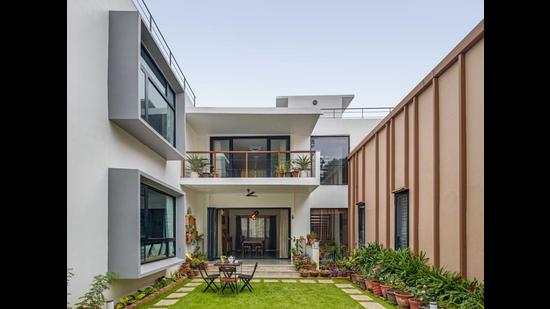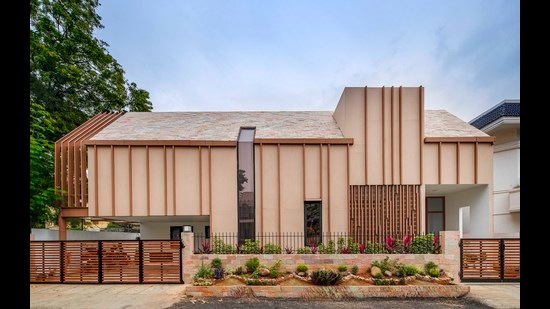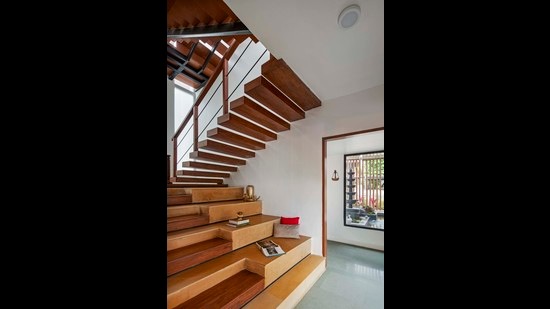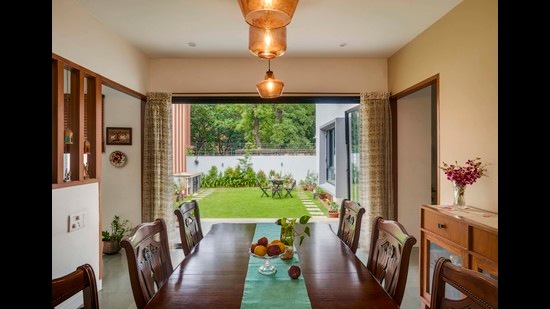Take a tour of the House of No Bricks in Coimbatore
The luxury private home has been built entirely with panels of GFRG or glass fibre reinforced gypsum. The walls are thinner but offer better insulation. Summers are much more bearable, says the family that lives there.
It’s an irony that architect Nirmal S John Britto originally conceived the House of No Bricks entirely in brick. “The clients are friends and I knew first-hand of their aspirations with the home,” says Britto, who heads the Coimbatore-based Urban Design Collaborative (UDC). “Since they are originally from Kerala, I had a notion that an exposed-brick house would appeal to them. But on deeper conversations with the family, I decided to prioritise design and let the choice of material follow from that.”

The clients were the Kuriens — Joseph, a businessman, his wife Daisy, 57, a homemaker, their sons Ashik, 32, and Akash, 29, and daughters-in-law Marina Mathew, 31, and Saira Elsa, 27.
Joseph and Daisy told Britto they wanted their Coimbatore home to be a celebration of their private life. They wanted no ostentation, but rather a contemporary design in place of the existing sloped-roof structure. Britto accordingly drew a plan for a two-storey, 4,200-sq-ft home of flowing spaces and natural light, with a lush lawn and garden that would act as a physical extension of the dining space and a visual extension of the living area and each of the four bedrooms.



There were no bricks in his eventual plan. The structure, he told the Kuriens, could be built entirely with panels of glass fibre reinforced gypsum (GFRG). Such panels are made using recycled waste or by-products from various industries, the key components being the glass fibre and gypsum, which make them durable and sustainable. Cavities in the panels are filled with steel reinforcement and concrete, depending on the structural requirements.
GFRG was first developed in Australia and has been used on a large scale there since the 1990s. It’s been in production and in use in India for a few years. It’s a material also used extensively in the Middle-East.
Unlike a conventional brick structure, GFRG walls do not need plastering. The material is cheaper, which reduces construction costs by about 10%. And the panels take up less space and offer better insulation than a conventional wall, allowing rooms to be roomier and reducing power consumption.
The Kuriens were hesitant at first. “Structural integrity, safety and maintenance were our main concerns,” says Ashik. To allay the family’s fears, Britto took them to see commercial buildings in the city that had been built using this material. “We were also building with GFRG at the time,” Britto says. “There weren’t other luxury private residences to show the family because the material has typically been used in government offices, hospitals and factories.” But that’s part of the reason he was eager to use it here, to prove one could make an elegant home, effectively and cost-effectively, in Indian conditions.
Akash, who was then living in Australia, confirmed that residents there were happy with the material. Friends and family from the Middle East helped iron out some concerns too. Britto and the UDC’s contracting team promised that maintenance would be very similar to a conventional building.
The Kuriens moved into the House of No Bricks in January 2019. Sadly, Joseph passed away soon after. The house became part of his legacy. And having experienced two cycles of seasons, the family says they are extremely happy at how it turned out.
“Our family and friends were apprehensive when we first discussed our construction with them. Everyone had their own take on why this wouldn’t work,” Ashik says. “But we find that summers are more manageable in the new home. There is a considerable difference in temperature inside and outside the house. And it is a blissful experience to sit on the deck and enjoy the monsoon.”
Britto now hopes the House of No Bricks will encourage other homeowners to adopt this greener material.
All Access.
One Subscription.
Get 360° coverage—from daily headlines
to 100 year archives.



HT App & Website






